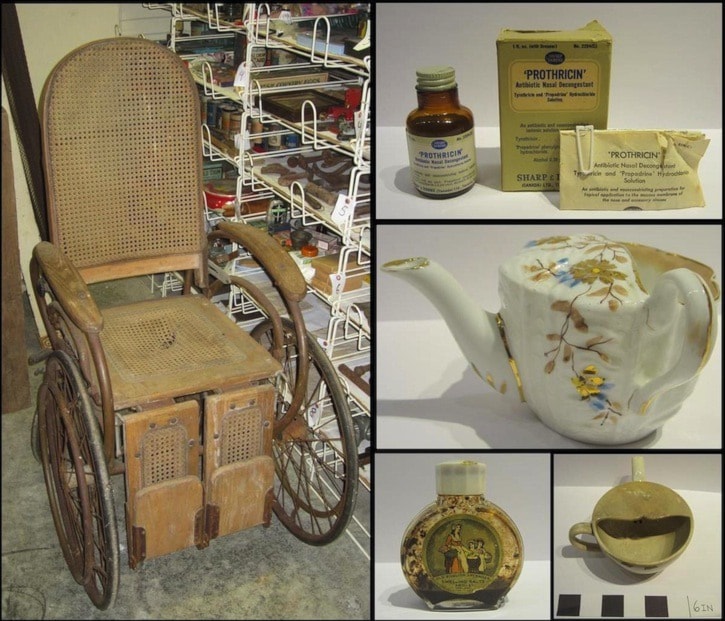This month we are discussing the medical artifacts in our collection. We have over 100 healthcare related artifacts, most of which are on display in our permanent medical exhibit. A medicology handbook, medicines, first aid supplies, surgical tools and other medical equipment are among our collection. While not all of these artifacts have Sooke related history, they all bring to life the story of medical care throughout Canada.
An artifact that is particularly admired by our collections team is a vintage wheelchair that was donated to the museum in 1977 (1977.081.001).The manual wheelchair has a metal frame with solid oak and wicker components. It has two small back wheels and two large front wheels, both with rubber tires. The front wheels have metal spokes. The seat has coiled metal springs under each corner and there is a cylindrical metal bar attached to the back of the chair so it can be pushed. The chair back can also be adjusted. There are metal brakes on both front wheels with a hand grip on the right side. Unfortunately, the metal on the wheelchair is rusted and there is a large tear in the wicker seat. The Royal Canadian Legion Branch #54 Woman’s Auxiliary used to lend this wheelchair, and others like it, to their members. While the date of origin of this wheelchair is uncertain, it is probably from the first quarter of the 1900s. Scholars believe wheelchairs are a 16th Century invention. Due to the large size of this artifact, it currently resides in storage.
Two artifacts in the medical exhibit are devices called invalid feeder cups. One is a medium sized, dark beige, round feeder cup with a crackle glaze (1977.017.001). Inside the base of the cup are four holes that allow liquid to pass through to the spout. This cup was brought to Vancouver Island from Scotland in 1826 and was donated to the museum in 1977. The other feeder cup is delicate white china with gold, blue and brown floral designs (1977.064.010). This feeder cup has only one hole for liquid to pass through. It was used in the early 1900s and also donated in 1977. Both feeder cups are half covered on top, which prevents liquid from spilling out while someone feeds from the spout. They both also have handles at the proper left of the spout, making it easier for care aids to assist with feeding. Invalid feeders were most commonly used in care homes, medical facilities and also in the Red Cross. Other instruments in the medical exhibit include calipers, forceps, ether applicator masks and a stethoscope.
Also amongst our artifact collection are various types of medicines and first aid supplies that are no longer available for purchase. For example we have an Old English lavender smelling salts bottle by the brand Yardley (1978.055.034a-b). The clear glass bottle with a cream coloured plastic lid is about a quarter filled with a brown liquid. The colourful label pictures a woman and two children outfitted in colonial dresses. The ammonia in smelling salts was used to revive someone who felt faint. Another medication we have is a bottle of Prothricin by the brand Sharpe and Dohme (1983.075.038a-c). The brown glass bottle is housed in its original box with the instruction booklet. The instructions describe this product as, “an antibiotic and vasoconstricting preparation for topical application to the mucous membrane of the nose and accessory sinuses.” The booklet also states this Prothricin solution is a combination of two agents: tyrothricin and Propadrine hydrochloride. There are no remnants of this medicine in the bottle. Both the smelling salts and Prothricin can be viewed in our medical exhibit. An example of first aid supplies on display is a vial filled with a preservative liquid and horse hair thread used for stitches (1990.035.001h). Also, in our storage, we have numerous types of Band-Aids, bandages, gauze and medical tapes.
Brianna
Shambrook
Collections and Exhibits
Manager
Sooke Region Museum
The Sooke Region Museum and Visitor Centre is located at 2070 Phillips Road, and is open throughout the year 9 am - 5 pm with the exception of Mondays during the winter season and a brief Christmas closing.
Phone:
250-642-6351
Toll free phone:
1-866-888-4748
E-mail us at: info@sookeregionmuseum.com
